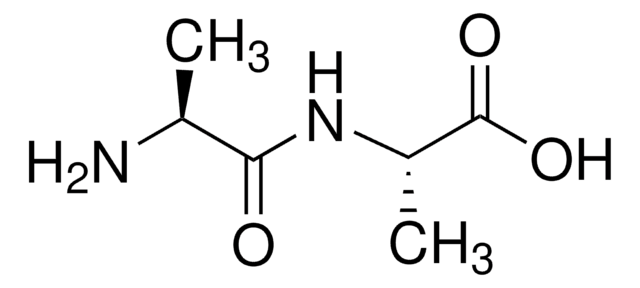Kluczowe dokumenty
G8541
Ala-Gln
200 mM, solution, sterile-filtered, Biotechnology Performance Certified
Synonim(y):
Alanyl-glutamine, Glutamine-S
About This Item
Polecane produkty
klasa czystości
Biotechnology Performance Certified
Poziom jakości
sterylność
sterile-filtered
Formularz
solution
stężenie
200 mM
zanieczyszczenia
endotoxin, tested
temp. przechowywania
2-8°C
ciąg SMILES
NC(CC[C@H](NC([C@@H](N)C)=O)C(O)=O)=O
InChI
1S/C8H15N3O4/c1-4(9)7(13)11-5(8(14)15)2-3-6(10)12/h4-5H,2-3,9H2,1H3,(H2,10,12)(H,11,13)(H,14,15)/t4-,5-/m0/s1
Klucz InChI
HJCMDXDYPOUFDY-WHFBIAKZSA-N
Szukasz podobnych produktów? Odwiedź Przewodnik dotyczący porównywania produktów
Opis ogólny
Zastosowanie
Inne uwagi
Kod klasy składowania
10 - Combustible liquids
Klasa zagrożenia wodnego (WGK)
WGK 1
Temperatura zapłonu (°F)
Not applicable
Temperatura zapłonu (°C)
Not applicable
Wybierz jedną z najnowszych wersji:
Masz już ten produkt?
Dokumenty związane z niedawno zakupionymi produktami zostały zamieszczone w Bibliotece dokumentów.
Klienci oglądali również te produkty
Produkty
Importance and uses of glutamine in hybridoma and mammalian cell culture
Znaczenie i zastosowanie glutaminy w hybrydomie i hodowli komórek ssaków
rganoid culture products to generate tissue and stem cell derived 3D brain, intestinal, gut, lung and cancer tumor organoid models.
Produkty do hodowli organoidalnej do generowania trójwymiarowych modeli mózgu, jelit, jelit, płuc i guzów nowotworowych pochodzących z tkanek i komórek macierzystych.
Nasz zespół naukowców ma doświadczenie we wszystkich obszarach badań, w tym w naukach przyrodniczych, materiałoznawstwie, syntezie chemicznej, chromatografii, analityce i wielu innych dziedzinach.
Skontaktuj się z zespołem ds. pomocy technicznej








